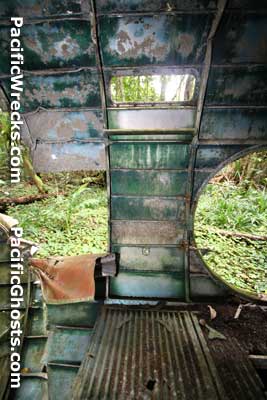American Aircraft
P-40 Warhawk
A unination tube, with a drain or suction was built in the cockpit. A RAAF pilot related a story about how his ground crew's error (or prank) that reverse the direction of the suction, and cause it to all go back into him.
A-20 Havoc
This aircraft had urination tube for the pilot or crew to use, while seated. The tube drained to a port on the outside of the aircraft.
B-17 Flying Fortress
A circular pot-type toilet was located in the rear fuselage, on the left side behind the waist door. There was a coat hook on the station towards the upper center as well (above the toilet).
C-47 Dakota
 Since Dakotas often carried passengers, its no surprise this aircraft had one of the better toilets. Behind a door, in the rear portion of the fuselage was a complete bathroom area. A toilet bowl was attached to the right side. Above, was a narrow window, allowing natural light into the compartment. A light bulb in the roof overhead, and a sink area on the left side.
Since Dakotas often carried passengers, its no surprise this aircraft had one of the better toilets. Behind a door, in the rear portion of the fuselage was a complete bathroom area. A toilet bowl was attached to the right side. Above, was a narrow window, allowing natural light into the compartment. A light bulb in the roof overhead, and a sink area on the left side.
Japanese Aircraft
Japanese Fighters
Fighter pilots used a bag, and urine was able to drain off. Maintenance men on the ground had to clean the cockpit on the ground before the next flight.
G3M2 Nell
This bomber did not have a toilet. For these reasons, some did not use the restroom during flights. However, in tropical areas where there were severe cases of diarrhea required some to use paper bags or bottles for urination they brought along. In Rabaul, crews often suffered severe diarrhea.
 G4M1 Betty
G4M1 Betty
Although it lacked sufficient crew armor or adequate self-sealing fuel tanks, the Betty bomber that clearly had the best toilet facilities. One veterans recalls how a crew member tried to urinate from the 20mm rear turret seat (which was open to the outside) however all returned onto him.
 The bomber's toilet was located in the rear fuselage, just aft of the fuselage door was a circular toilet pot, that a crew member could sit onto. Also, a bar above the toilet allowed for the crew member to stand and hold onto the bar for support while urinating. Most comfortable of all was the fact that a narrow rectangular shaped window was right above the toilet at eye level when urinating. An exhaust pipe was installed to a hole to outside, to allow the smell to exit, yet this was not very effective, and the waist compartment was often filled with a bad smell, requiring a window in the cockpit to be opened. The toilet seat was made of wood, attached to a stool, fixed inside the aircraft, with an inner container that was removable. This task of emptying it was assigned to the youngest member of the crew.
The bomber's toilet was located in the rear fuselage, just aft of the fuselage door was a circular toilet pot, that a crew member could sit onto. Also, a bar above the toilet allowed for the crew member to stand and hold onto the bar for support while urinating. Most comfortable of all was the fact that a narrow rectangular shaped window was right above the toilet at eye level when urinating. An exhaust pipe was installed to a hole to outside, to allow the smell to exit, yet this was not very effective, and the waist compartment was often filled with a bad smell, requiring a window in the cockpit to be opened. The toilet seat was made of wood, attached to a stool, fixed inside the aircraft, with an inner container that was removable. This task of emptying it was assigned to the youngest member of the crew.
Thank to Yoji Sakaida for Japanese aircraft research and crew stories and drawing.
Additional thanks to Brian Bennett